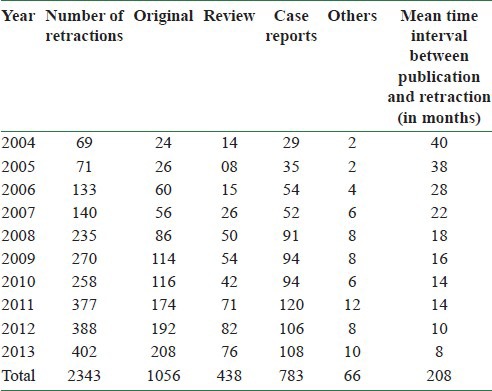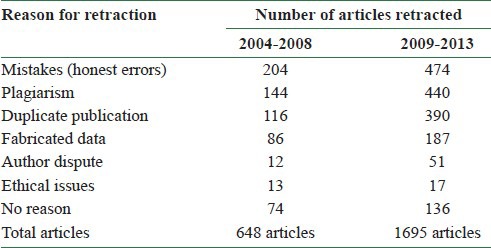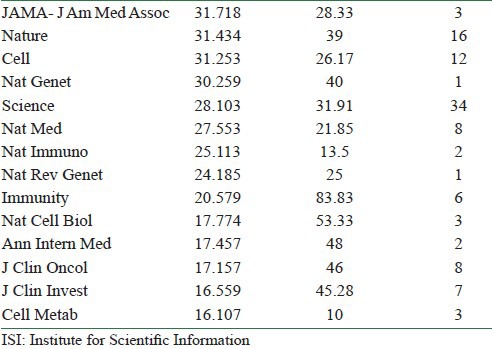Abstract
Science is a dynamic subject and it was never free of misconduct or bad research. Indeed, the scientific method itself is intended to overcome mistakes and misdeeds. So, we aimed to assess various factors associated with retraction of scientific articles from 2004 to 2013. Data were retrieved from PubMed and Medline using the keywords retraction of articles, retraction notice, and withdrawal of article in April 2014 to detect articles retracted from 2004 to 2013. Statistical analysis was carried out using t-test and Karl Pearson's correlation coefficient. Results showed that a total of 2343 articles were retracted between 2004 and 2013, and original articles followed by case reports constituted major part of it. Time interval between submission and retraction of article has reduced in recent times. Impact factor and retraction do not have any significant correlation. We conclude that although retraction of articles is a rare event, its constant rise in scientific literature is quite worrisome. It is still unclear whether misconduct/mistakes in articles are increasing hastily or the articles are retracted at a rapid rate in recent times. So, it should be considered as an urgent issue and it is the responsibility of journal editors to track misconduct by following Committee on Publication Ethics (COPE) guidelines and making an effective strategy.
Keywords: Duplication of article, Plagiarism, Retraction of articles, Self-correction
INTRODUCTION
Retraction refers to an article in its entirety that is the result of a pervasive error, non-reproducible research, scientific misconduct, or duplicate publication. Retractions identify an article that was previously published and is now retracted through a formal issuance from the author, editor, publisher, or other authorized agent.[1] The number of articles retracted has increased rapidly in recent years.[2] The number of retractions in journals covered by the Science Citation Index Expanded has increased 20 times between 1990 and 2008.[3] So, we aimed to study various factors governing retraction of scientific articles by analyzing all the retracted articles between 2004 and 2013.
SELECTION OF DATA
Data were retrieved using PubMed and Medline, a bibliographic database of biomedical literature, using the keywords retraction of articles, retraction notice, and withdrawal of article in April 2014 to detect articles retracted from 2004 to 2013, and were spread over Microsoft Excel sheet. We assessed all the factors associated with retraction of articles where the text was available in English. For each retraction, we recorded the article type (e.g. original research, review article, case report, letter) and the reason for the retraction (e.g. data fabrication or falsification, suspected fraud, scientific error, unethical, plagiarism, duplicate publication, or other causes like publisher error, authorship disputes, copyright infringement, or unknown causes). We also noted the time interval between publication and retraction of a particular article. We also selected the 15 journals with 2012 Institute for Scientific Information (ISI) impact factor (IF) more than 15 given by Thomson Reuters, and analyzed the number of articles retracted in these journals and also the time period between publication and retraction of the article. Results obtained were analyzed statistically by t-test and Karl Pearson's correlation coefficient applying Statistical Package for the Social Sciences (SPSS) software. P value less than 0.05 is considered as statistically significant.
A total of 2343 articles were retracted between 2004 and 2013 and were considered for evaluation [Table 1]. Table 1 shows that in both 2004-2008 and 2009-2013 periods, original articles followed by case reports and reviews constituted maximum percentage of total retracted articles.
Table 1.
Various types of retracted articles and the time mean time interval between publication and retraction of articles

Various reasons for retraction of articles
In Table 2 are presented the various reasons for retraction of articles, which shows the most cited reasons as mistakes, plagiarism, and duplicate submission over the period of 10 years [Table 2]. While determining whether the use of plagiarism detection software may have increased the detection of plagiarism in published articles, we found that the time interval between publication and retraction of articles had reduced significantly in 2009-2013 as compared to 2004-2008 [Table 3]. Table 3 shows that the time interval between publication and retraction has reduced significantly in recent times (2009-2013) as compared to previous years (2004-2008).
Table 2.
Reasons for retraction of articles from 2004 to 2008 and from 2009 to 2013

Table 3.
Mean time interval between publication and retraction (in months)

Impact factor and retraction of articles
Correlation was determined between the number of articles retracted and the time between retraction and publication for all journals having an IF more than 15 using Pearson's correlation coefficient [Table 4]. Table 5 shows that there was statistically nonsignificant relation between the IF, the number of articles retracted, and the time between retraction and publication.
Table 4.
Journals with 2012 ISI impact factor more than 15 in relation to retraction of articles assessed between 2 April and 18 April 2014

Table 5.
Correlation between the number of articles retracted in 2004-2013 and the time between retraction and publication in 15 journals having an impact factor more than 15

Committee on publication ethics described retraction as a mechanism for correcting the literature and alerting readers to publications that contain such seriously flawed or erroneous data that their findings and conclusions cannot be relied upon.[4] A total of 2343 retracted articles were found between 2004 and 2013. Corbyn et al.[3] evaluated the retracted articles in 1990-2008 and Cokol et al.[2] in 1950-2007, and found nearly 10-fold increase in the incidence of retraction.
Type of articles retracted
We observed that most of the articles retracted in scholarly literature are original articles followed by case reports and review articles [Table 1]. So, we can say that there is more potential of fraudulent data in experimental studies than in other types of articles. Fraudulent data are not new in science. Gregor Mendel, the father of genetics, may have selectively modified his data in support of his results, and statistics suggested that Mendel's data are biased in the direction of agreement with expectation.[5]
Present study revealed that mistakes and plagiarism are the major reasons cited for article retractions than other reasons such as plagiarism, duplicate submission, fabricated data, or ethical disputes [Table 2]. Similar findings were also obtained in a previous study by Nath et al.,[6] who evaluated retractions listed in Medline between 1982 and 2002. They observed that misconduct attributed to 27% of retracted articles and errors constituted 62% of retraction. However, they failed to provide more descriptive categorization of the reasons for retractions. Wager et al.[7] also found honest errors (28%), redundant publication (17%), and plagiarism (16%) as the major reasons behind retraction of articles. This is a serious issue since it is a disgraceful act in scientific writing and represents one of the biggest challenges faced by the scholarly world. So, we strongly believe that academic misconduct must be recognized at the earliest and significant reduction can be brought by awareness, objective check methods, and stringent punishment.
Why journal editors have not declared reason for retraction
Present study showed that in 11% of the articles retracted in 2004-2008 and in 8% of the articles retracted in 2009-2013, no reason for retraction was stated or the language was so unclear that the reason could not be determined [Table 2]. Similarly, in previous year, a study conducted by Wager et al.[7] on the articles retracted between 1988 and 2008 showed that 5% of retracted articles did not state the reason for retraction. Journal editors may be reluctant to print retractions with sufficient information as they fear legal action by the authors. This shows some discomfort on the part of authors and journals in admitting mistakes.[6] According to Committee on Publication Ethics (COPE), authors usually would not have grounds for taking any legal action if it follows a suitable investigation and proper procedures.[4] Retractions may be due to genuine mistakes by authors, so it is important to mention the reason for retraction in retraction notices. Authors who have acted honestly and responsibly informed the journal editors about flaws of their work should not be stigmatized along with others who commit gross misconduct. This has also been emphasized in COPE guidelines.[4,8] The National Library of Medicine (NLM) adopted a new policy according to which they chose to link the notice of retraction to the original article rather than delete the citation of the retracted article, because they felt that removal might affect historical perspective.[9]
Quantity increased but quality decreased
In regard to quantity of publications worldwide, the first and second positions are bagged by the US and UK with 22,969 and 8069 publications, respectively, and India represents 2296 publications. In terms of quality of research, Switzerland occupies the highest position followed closely by the US (based on the number of citations received). Hence, we can say that mere upsurge in the quantity of publications does not indicate increased quality of research work in the country.[10] This goes in accordance with one famous saying, “You can put millions of farmers to cultivate, but you need some real scientists to make green revolution.”
Time between retraction and publication
Unfortunately, retraction notices take a long time to reach the target readers after the article is published and it remains a chronic problem. Present study showed that the time interval between publication and retraction has reduced significantly in recent times (2009-2013) as compared to previous years [Table 3]. Steen et al.[11] also observed that among 714 retracted articles published between 1973 and 2002, retraction took an average of 49.82 months and among 1333 retracted articles published after 2002, retraction required 23.82 months, and thus concluded that retraction may be occurring more quickly now than in the past.
Is there any relation between high impact factor journals and frequency of retraction of articles
The IF is a bibliometric parameter based on the number of times that papers in a particular journal are cited by all journals. It is considered a parameter of the scientific quality of a journal. IF is a reasonable surrogate for peer scrutiny as high-IF journals are cited more widely because they are seen more widely. When all retractions were scrutinized in all journals having 2012 ISI IF more than 15, no correlation was observed between time to retraction and journal IF. Only 15 journals having an IF more than 15, listed in Table 4, showed retraction notices, whereas the other 60 journals did not reveal any retraction notice. Similar results have also been obtained by Fang et al.,[12] who observed retractions in 64% of all research journals with an IF of 9.000 or greater. Some authors have noticed an association between IF and the reasons for retraction being published in higher-IF journals. This could be explained by the fact that some authors might hurry to publish in a prestigious journal without taking enough time to check their data. When a paper deals with a hot topic, journals tend to publish special issues very rapidly.[13]
Citation and retraction of articles
Editors of few journals resist in retracting articles, even when proved with gross evidence of fraud, as the fact remains that flawed research has slipped through the peer-review process of most of the top journals in science and medicine and such a publication besmirches the image of a journal and sullies the ethical standards of scientific publication.[12] In our study we were surprised to find that an article published by Bezouska et al. (1994) in Nature was retracted after a long time of 19 years in 2013 as they failed to reproduce the results and it has been cited 255 times according to Thomson Scientific's Web of Knowledge.[14] Retracted articles still continue to be cited as valid studies years after retraction notices had been issued.[11,15] There is not sufficient evidence available that retraction notices make much difference to the citation behavior of authors, while there is evidence that articles receive fewer citations after retraction compared to a control group and highly cited articles continue to be frequently cited after retraction.[9]
Perspectives and future direction
Scientific misconduct should not be tolerated and the journal editor should be alert and make an effective strategy to curb this menace at the root level by ensuring implementation of COPE guidelines. The main objective of retractions is to rectify the literature and ensure its academic and research integrity rather than punishing any authors. We believe that “naming, shaming, and blaming” does not seem to be appropriate for handling unintentional or honest errors, but rather it should be an opportunity for learning and improvement.[16,7,11] It is still unclear whether misconduct/mistakes in articles are increasing hastily or the articles are retracted at a rapid rate in recent times. This study has a limitation that it is restricted to the retractions indexed in the Medline database and, therefore, reflects a biomedical bias to its generalization.
We conclude that retractions represent small fraction of a percent among all publications for any given field in any year. So, we suggest that editors should evolve some strategy by implementing COPE guidelines in order to reduce such misconduct as it adversely affects not only the scientific community but also the general public. Original articles should remain freely available with a clear mention of the retraction, which should not only be mentioned on the journal website or in notes at the beginning or end of the article.
REFERENCES
- 1. [Last accessed on 2014 Apr 02]. Available from: http://www.councilscienceeditors.org/i4a/pages/index.cfm?pageid=3647 .
- 2.Cokol M, Ozbay F, Rodriguez-Esteban R. Retraction rates are on the rise. EMBO Rep. 2008;9:2. doi: 10.1038/sj.embor.7401143. [DOI] [PMC free article] [PubMed] [Google Scholar]
- 3.Corbyn Z. Higher Education: Times; 2009. Vol. 1. New Jersey: On Fact and Fraud; Princeton University Press; 2010. [Last accessed on 9 March, 2014]. Retractions up tenfold; p. 27. Available from: www.timeshighereducation.co.uk/story./story.asp?storycode=407838 Goodstein, D . [Google Scholar]
- 4.Wager E, Barbour V, Yentis S, Kleinert S. Retractions: Guidance from the Committee on Publication Ethics (COPE) 2009. [Last accessed on 2014 Apr 04]. Available from: http://publicationethics.org/files/u661/Retractions_COPE_gline_final_3_Sept_09__2_.pdf . [DOI] [PubMed]
- 5.Galton DJ. Did Mendel falsify his data? QJM. 2012;105:215–6. doi: 10.1093/qjmed/hcr195. [DOI] [PubMed] [Google Scholar]
- 6.Nath SB, Marcus SC, Druss BG. Retractions in the research literature: Misconduct or mistakes? Med J Aust. 2006;185:152–4. doi: 10.5694/j.1326-5377.2006.tb00504.x. [DOI] [PubMed] [Google Scholar]
- 7.Wager E, Williams P. Why and how do journals retract articles? An analysis of Medline retractions 1988–2008. J Med Ethics. 2011;37:567–70. doi: 10.1136/jme.2010.040964. [DOI] [PubMed] [Google Scholar]
- 8.Singh HP, Kaur N. Knowledge and attitude of dental professionals of north india towards plagiarism. North Am J Med Sci. 2014;6:1–6. doi: 10.4103/1947-2714.125854. [DOI] [PMC free article] [PubMed] [Google Scholar]
- 9.Atlas MC. Retraction policies of high-impact biomedical journals. J Med Libr Assoc. 2004;92:242–50. [PMC free article] [PubMed] [Google Scholar]
- 10.Imago SC. SJR – SC Imago Journal and Country Rank. 2007. [Last accessed on 2014 Mar 11]. Available from: http://www.scimagojr.com .
- 11.Steen RG, Casadevall A, Fang FC. Why has the number of scientific retractions increased? PLoS One. 2013;8:e68397. doi: 10.1371/journal.pone.0068397. [DOI] [PMC free article] [PubMed] [Google Scholar]
- 12.Fang FC, Casadevall A. Retracted science and retraction index. Infect Immun. 2011;79:3855–9. doi: 10.1128/IAI.05661-11. [DOI] [PMC free article] [PubMed] [Google Scholar]
- 13.Decullier E, Huot L, Samson G, Maisonneuve H. Visibility of retractions: A cross-sectional one-year study. BMC Res Notes. 2013;6:238. doi: 10.1186/1756-0500-6-238. [DOI] [PMC free article] [PubMed] [Google Scholar]
- 14.Retraction: Oligosaccharide ligands for NKR-P1 protein activate NK cells and cytotoxicity. Nature. 2013;500:490. doi: 10.1038/nature12383. [DOI] [PubMed] [Google Scholar]
- 15.Budd JM, Sievert M, Schultz TR. Phenomena of retraction: Reasons for retraction and citations to the publications. JAMA. 1998;280:296–7. doi: 10.1001/jama.280.3.296. [DOI] [PubMed] [Google Scholar]
- 16.Redman BK, Yarandi HN, Merz JF. Empirical developments in retraction. J Med Ethics. 2008;34:807–9. doi: 10.1136/jme.2007.023069. [DOI] [PubMed] [Google Scholar]


